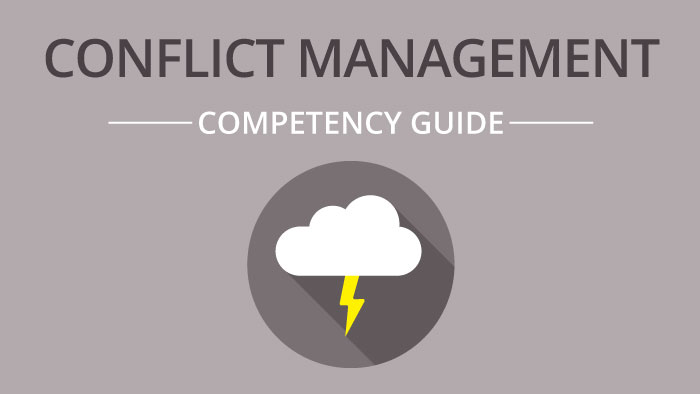By Erin Boettge

Dealing with conflict in the workplace is unavoidable. The ability to recognize conflict between employees, understand the nature of it, and use techniques to bring a quick and fair resolution to conflict is a critical skill for managers and leaders.
Whether you’re a manager or an employee, at some point in your career you’ll need skills for managing conflict in the workplace.
These nine tips and techniques will help with resolving conflict at work, whether they’re little disagreements or major blow ups.
Share these tips with others! Download the full guide here:
1. Always keep in mind that the primary goal is to maintain good working relationships.
Remember, at work, it’s all about the performance of your team. Employees need to learn how to resolve conflict without letting it affect their relationships with each other, or the quality of the team’s work.
It’s important that you keep this in mind before assessing a situation.
2. Sometimes you need to agree to disagree.
If you’re a manager or supervisor, you can create a team culture where disagreement is okay, can be appreciated, encouraged, and expected.
Since we all have different opinions, disagreement comes naturally at work. Every opinion matters, so disagreements should be dealt with professionally and fairly.
3. Pay attention to the disagreement or conflict that goes unsaid.
Sometimes, disagreements are not discussed. For example, a new employee is not likely to speak up about something he or she disagrees with right away. As a manager, you need to build trust with your direct reports and be an active part of the team.
You need to read the signs. You may see negative body language at a meeting or during a conversation… rolling the eyes, quick facial flash of disgust or disbelief, leaning over to make a comment to the person sitting next to them, or even a silent snort.
Be alert for any negative statements, sarcastic comments, or barbs.
Also be alert for any push-back in employees’ actions. You may notice your team members venting to each other, and then they stop when you walk up.
4. Look at things from the other person’s point of view.
That sounds pretty obvious, but it still needs saying. Other people’s viewpoints are just as valid to them as yours is to you.
We’re often so focused on our own version of what should be, that we lose sight of how others may feel about it.
Handling conflict at work well requires considering other viewpoints and understanding what’s so compelling about those positions versus yours.
5. Only speak for yourself.
It’s one thing to understand others. It’s another thing to assume you know their position, and to take that position for them.
As a manager, you’ll get better results if you let your people speak for themselves, and you act as the facilitator to make sure the discussion is productive.
6. Be careful what you say.
As a disagreement begins to escalate into an argument, it’s easy to let emotion into the discussion. Once you say something, you can never take it back.
Keep things professional. Use a calm voice. Insist on a “no put-downs” rule, and immediately stop anyone who violates it. Keep the conversation about the matters at hand.
7. Don’t disagree by email.
Although many of us love to vent in print, in general, it’s not a good medium for handling conflict. Even if you’re a good writer, it’s just too hard to convey everything you need to say at 40 words-per-minute.
Plus, with writing, it’s too hard to include any emotional nuances. What you meant to say can easily be miswritten, misinterpreted, or misunderstood. It happens all the time.
Also, emails are forever. You can’t un-send them. It’s easy to write something when you’re fired up, and then later regret it.
If you have something disagreeable to convey to someone, go see them face-to-face. Or at least call them on the phone. It’ll be a much more productive communication experience. By all means, take notes if they’ll help you, but don’t rely only on what you’ve written to deal with the conflict.
8. Listen, then speak.
As Stephen Covey puts it in his 7 Habits, “Seek first to understand, then to be understood.”
We know what we think is right. So we always want to speak first to convince others. When both sides approach it that way, then no one’s listening.
Active listening is one of the most basic techniques there is for managing conflict in the workplace, so this is an especially important skill to learn and teach others.
9. Focus on the intent versus the impact.
It’s a great way to defuse rising tension. If someone goes a bit over the line and doesn’t realize it, you can ask an intent/impact question that takes this form: “Is this what you meant to do (or say) because this is how it came across.”
In essence, you’re giving the other person a do-over, a second chance to say something that may have come out wrong, or been misinterpreted.
Providing conflict resolution training to employees can significantly improve the effectiveness and engagement of your teams. If you’re looking for modern training on soft skills like this, be sure to check out what The BizLibrary Collection has to offer.
Here’s a preview of “Productively Resolving Conflicts” to give you a quick look at what our online video training is like:

Erin Boettge researches and writes on a variety of business topics, including workplace dynamics, HR strategies, and training trends and technology.

